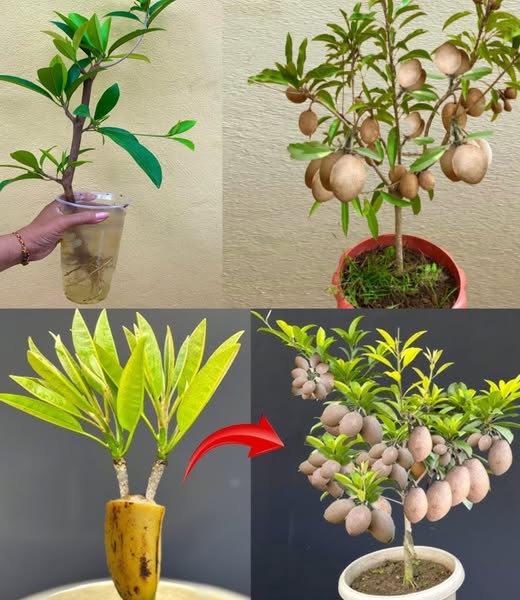How to Grow a Sapodilla Plant from Cuttings Using a Banana: A Simple Guide
Growing a sapodilla plant from cuttings can be a rewarding and exciting gardening project. But did you know that you can enhance the rooting process by using something as simple as a banana? This unique method helps the sapodilla cutting establish roots more quickly and with greater success. In this article, we will walk you through the process of growing sapodilla from cuttings using a banana, and the best tips to ensure your new plant thrives!
Why Use a Banana for Rooting Sapodilla Cuttings?
Bananas are packed with natural nutrients such as potassium and magnesium, which can help boost the root development of plant cuttings. When used as a rooting medium for sapodilla cuttings, bananas provide the essential sugars and moisture that encourage healthy root formation.
Bananas also have anti-fungal properties, which help prevent the growth of mold and rot, ensuring the cutting stays healthy as it begins to grow into a new plant. This method is a fantastic way to propagate your sapodilla tree in a very simple, natural way.
Materials Needed:
Before you begin, gather the following materials:
A healthy sapodilla cutting
A ripe banana (preferably organic)
A sharp knife or pruning shears
A small pot or container
Well-draining soil
Water
Step-by-Step Guide to Growing Sapodilla from Cuttings Using a Banana:
1. Prepare the Cutting
Choose a healthy sapodilla tree from which to take the cutting. The cutting should be around 6-8 inches long and contain at least a couple of leaf nodes (the points where leaves grow).
Make a clean cut just below a node using a sharp knife or pruning shears. Remove any excess leaves to reduce moisture loss.
Allow the cutting to dry for a few hours to prevent rotting before placing it in the banana.
2. Prepare the Banana
Peel the ripe banana, leaving the banana peel intact.
Cut the banana in half or into pieces that will fit the container where you plan to root the cutting.
Slightly mash the banana pieces with your hands or a spoon to release some of the natural sugars and moisture, which will help nourish the cutting.
3. Insert the Cutting into the Banana
Create a small slit or hole in the mashed banana with your fingers or a knife, just big enough to fit the cutting.
Place the cutting into the banana, ensuring the cut end of the cutting makes contact with the banana. This will allow the cutting to absorb moisture and nutrients from the banana as it begins to root.
The banana will act as a natural rooting hormone, helping the cutting root faster
4. Place the Cutting in a Pot
After inserting the cutting into the banana, place the whole setup in a small pot or container. Fill the pot with well-draining soil, making sure the cutting stays upright.
Gently cover the banana with soil to hold it in place.
5. Maintain Humidity and Watering
Place the pot in a warm, sunny spot that receives indirect sunlight. Keep the soil consistently moist, but not soggy.
You can also cover the pot with a plastic bag or plastic dome to maintain humidity around the cutting, which will help with rooting.
Be sure to check the cutting regularly, and spray a light mist of water if the soil begins to dry out.
6. Wait for Rooting
Over the next 3-4 weeks, the sapodilla cutting will start developing roots. Once the roots are strong and the cutting starts showing signs of new growth, you can remove the plastic covering.
Gently tug on the cutting to see if it has rooted. If you feel resistance, it’s time to transplant it into a larger pot or directly into your garden.
Tips for Success in Propagating Sapodilla from Cuttings Using a Banana:
Choose healthy, mature cuttings from a sapodilla tree for better results. Avoid using overly soft or greenwood.
Use a ripe banana for the best rooting results. Overripe bananas work well due to their rich sugar content.
Ensure that your soil is well-draining. Sapodilla plants don’t like soggy roots.
Keep the humidity high around the cutting to prevent it from drying out and ensure better rooting.
Be patient—this method may take a little time, but the results will be worth the wait.
Conclusion: Grow Your Own Sapodilla Plant with a Banana!
Growing a sapodilla plant from cuttings using a banana is a simple, natural, and effective method for propagating this delightful fruit tree. With just a few basic materials and some patience, you can encourage the cutting to develop healthy roots and grow into a strong, thriving plant.
By incorporating the banana peel’s natural nutrients and moisture, you’ll speed up the rooting process, giving your sapodilla cutting the best start possible. Try this technique today and watch as your sapodilla tree flourishes right from a simple cutting! ![]()
![]()
![]()
